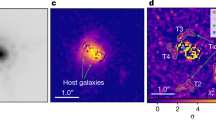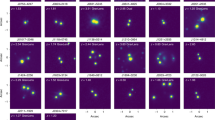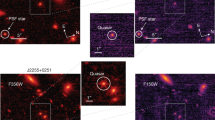Abstract
Galaxy mergers occur frequently in the early Universe1 and bring multiple supermassive black holes (SMBHs) into the nucleus, where they may eventually coalesce. Identifying post-merger-scale (that is, less than around a few kpc) dual SMBHs is a critical pathway to understanding their dynamical evolution and successive mergers2. Whereas serendipitous discovery of ~kpc-scale dual SMBHs at z < 1 is possible3, such systems are elusive at z > 2 but critical in constraining the progenitors of SMBH mergers. The redshift z ≈ 2 also marks the epoch of peak activity of luminous quasars4, and therefore the probing of this spatial regime at high redshift is of particular importance in understanding the evolution of quasars. However, given stringent resolution requirements, there is currently no confirmed <10 kpc physical SMBH pair at z > 2 (refs. 5,6,7,8). Here, we report two sub-arcsec double quasars at z > 2 that were discovered from a targeted search with a novel astrometric technique, demonstrating a high success rate (≳50%) in this systematic approach. These high-redshift double quasars could be the long-sought kpc-scale dual SMBHs, or sub-arcsec gravitationally lensed quasar images. One of these double quasars (at z = 2.95) was spatially resolved with optical spectroscopy, and slightly favours the scenario of a physical quasar pair with a projected separation of 3.5 kpc (0.46″). Follow-up observations of double quasars discovered by this targeted approach will be able to provide observational constraints on kpc-scale dual SMBHs at z > 2.
This is a preview of subscription content, access via your institution
Access options
Access Nature and 54 other Nature Portfolio journals
Get Nature+, our best-value online-access subscription
$29.99 / 30 days
cancel any time
Subscribe to this journal
Receive 12 digital issues and online access to articles
$119.00 per year
only $9.92 per issue
Buy this article
- Purchase on Springer Link
- Instant access to full article PDF
Prices may be subject to local taxes which are calculated during checkout



Similar content being viewed by others
Data availability
The SDSS spectrum for J0841 is publicly available at https://www.sdss.org/. The HST data are publicly available via the Mikulski Archive for Space Telescopes (MAST) at https://archive.stsci.edu with program no. HST-GO-15900. The raw data for the Gemini spectrum are publicly available at https://archive.gemini.edu/ with program ID GN-2020A-DD-106, and the reduced spectrum is provided in the data for Fig. 2. The catalogue data for parent SDSS quasars are available in refs. 15,16, and the astrometric data are publicly available from Gaia DR2 at https://gea.esac.esa.int/archive/. Additional data (preliminary VLBA images) that support the plots within this paper and other findings of this study are available from the corresponding author upon reasonable request. Source data are provided with this paper.
Code availability
The GALFIT code used to decompose the HST images is publicly available at https://users.obs.carnegiescience.edu/peng/work/galfit/galfit.html.
References
Duncan, K. et al. Observational constraints on the merger history of galaxies since z ≈ 6: probabilistic galaxy pair counts in the CANDELS fields. Astrophys. J. 876, 110 (2019).
Begelman, M. C., Blandford, R. D. & Rees, M. J. Massive black hole binaries in active galactic nuclei. Nature 287, 307–309 (1980).
Komossa, S. et al. Discovery of a binary active galactic nucleus in the ultraluminous infrared galaxy NGC 6240 using Chandra. Astrophys. J. Lett. 582, L15–L19 (2003).
Richards, G. T. et al. The Sloan Digital Sky Survey quasar survey: quasar luminosity function from Data Release 3. Astron. J. 131, 2766–2787 (2006).
Hennawi, J. F. et al. Binary quasars in the Sloan Digital Sky Survey: evidence for excess clustering on small scales. Astron. J. 131, 1–23 (2006).
Hennawi, J. F. et al. Binary quasars at high redshift. I. 24 new quasar pairs at z ~ 3–4. Astrophys. J. 719, 1672–1692 (2010).
More, A. et al. The SDSS-III BOSS quasar lens survey: discovery of 13 gravitationally lensed quasars. Mon. Not. R. Astron. Soc. 456, 1595–1606 (2016).
Eftekharzadeh, S. et al. Clustering on very small scales from a large sample of confirmed quasar pairs: does quasar clustering track from Mpc to kpc scales? Mon. Not. R. Astron. Soc. 468, 77–90 (2017).
Liu, Y. Finding binary active galactic nuclei candidates by the centroid shift in imaging surveys. II. Testing the method with SDSS J233635.75-010733.7. Astron. Astrophys. 592, L4 (2016).
Hwang, H.-C. et al. Varstrometry for off-nucleus and dual sub-kpc AGN (VODKA): methodology and initial results with Gaia DR2. Astrophys. J. 888, 73 (2020).
MacLeod, C. L. et al. Modeling the time variability of SDSS Stripe 82 quasars as a damped random walk. Astrophys. J. 721, 1014–1033 (2010).
Refsdal, S. On the possibility of determining Hubble’s parameter and the masses of galaxies from the gravitational lens effect. Mon. Not. R. Astron. Soc. 128, 307 (1964).
Gaia Collaboration. The Gaia mission. Astron. Astrophys. 595, A1 (2016).
Gaia Collaboration. Gaia Data Release 2. Summary of the contents and survey properties. Astron. Astrophys. 616, A1 (2018).
Shen, Y. et al. A catalog of quasar properties from Sloan Digital Sky Survey Data Release 7. Astrophys. J. Suppl. Ser. 194, 45 (2011).
Pâris, I. et al. The Sloan Digital Sky Survey quasar catalog: fourteenth data release. Astron. Astrophys. 613, A51 (2018).
Lindegren, L. et al. Gaia Data Release 2. The astrometric solution. Astron. Astrophys. 616, A2 (2018).
Lindegren, L. et al. The astrometric core solution for the Gaia mission. Overview of models, algorithms, and software implementation. Astron. Astrophys. 538, A78 (2012).
Lemon, C. A., Auger, M. W., McMahon, R. G. & Koposov, S. E. Gravitationally lensed quasars in Gaia: I. Resolving small-separation lenses. Mon. Not. R. Astron. Soc. 472, 5023–5032 (2017).
Pindor, B., Turner, E. L., Lupton, R. H. & Brinkmann, J. Determining the lensing fraction of SDSS quasars: methods and results from the Early Data Release. Astron. J. 125, 2325–2340 (2003).
Kayo, I. & Oguri, M. Very small scale clustering of quasars from a complete quasar lens survey. Mon. Not. R. Astron. Soc. 424, 1363–1371 (2012).
Bahcall, J. N., Maoz, D., Schneider, D. P., Yanny, B. & Doxsey, R. Hubble Space Telescope imaging of the large-redshift gravitational lens candidate 1208 + 1011. Astrophys. J. Lett. 392, L1 (1992).
Irwin, M. J., Ibata, R. A., Lewis, G. F. & Totten, E. J. APM 08279 + 5255: an ultraluminous broad absorption line quasar at a redshift z = 3.87. Astrophys. J. 505, 529–535 (1998).
Fan, X. et al. The discovery of a gravitationally lensed quasar at z = 6.51. Astrophys. J. Lett. 870, L11 (2019).
Djorgovski, S. Quasar pairs at large redshifts. ASP Conf. Ser. 21, 349–353 (1991).
Kochanek, C. S., Falco, E. E. & Muñoz, J. A. Why quasar pairs are binary quasars and not gravitational lenses. Astrophys. J. 510, 590–596 (1999).
Eftekharzadeh, S. et al. Clustering of intermediate redshift quasars using the final SDSS III-BOSS sample. Mon. Not. R. Astron. Soc. 453, 2779–2798 (2015).
Yu, Q. Evolution of massive binary black holes. Mon. Not. R. Astron. Soc. 331, 935–958 (2002).
Elmegreen, B. G. et al. Bulge and clump evolution in Hubble Ultra Deep Field clump clusters, chains and spiral galaxies. Astrophys. J. 692, 12–31 (2009).
Liu, X., Greene, J. E., Shen, Y. & Strauss, M. A. Discovery of four kpc-scale binary active galactic nuclei. Astrophys. J. Lett. 715, L30–L34 (2010).
Shen, Y., Hwang, H.-C., Zakamska, N. & Liu, X. Varstrometry for off-nucleus and dual sub-kpc AGN (VODKA): how well centered are low-z AGN? Astrophys. J. Lett. 885, L4 (2019).
Arenou, F. et al. Gaia Data Release 2. Catalogue validation. Astron. Astrophys. 616, A17 (2018).
Peng, C. Y., Ho, L. C., Impey, C. D. & Rix, H.-W. Detailed decomposition of galaxy images. II. Beyond axisymmetric models. Astron. J. 139, 2097–2129 (2010).
Tody, D. The IRAF data reduction and analysis system. Proc. SPIE 627, 733 (1986).
Sluse, D. et al. Microlensing of the broad line region in 17 lensed quasars. Astron. Astrophys. 544, A62 (2012).
Shen, Y. The mass of quasars. Bull. Astron. Soc. India 41, 61–115 (2013).
Shen, Y. et al. The Sloan Digital Sky Survey Reverberation Mapping project: sample characterization. Astrophys. J. Suppl. Ser. 241, 34 (2019).
Oguri, M. The image separation distribution of strong lenses: halo versus subhalo populations. Mon. Not. R. Astron. Soc. 367, 1241–1250 (2006).
Kinney, A. L. et al. Template ultraviolet to near-infrared spectra of star-forming galaxies and their application to K-corrections. Astrophys. J. 467, 38 (1996).
Bernardi, M. et al. Early-type galaxies in the Sloan Digital Sky Survey. II. Correlations between observables. Astron. J. 125, 1849–1865 (2003).
Sheth, R. K. et al. The velocity dispersion function of early-type galaxies. Astrophys. J. 594, 225–231 (2003).
Bezanson, R. et al. Redshift evolution of the galaxy velocity dispersion function. Astrophys. J. Lett. 737, L31 (2011).
Oguri, M. Strong gravitational lensing of explosive transients. Rep. Prog. Phys. 82, 126901 (2019).
Ross, N. P. et al. The SDSS-III Baryon Oscillation Spectroscopic Survey: the quasar luminosity function from Data Release Nine. Astrophys. J. 773, 14 (2013).
Silverman, J. D. et al. Dual supermassive black holes at close separation revealed by the Hyper Suprime-Cam Subaru Strategic Program. Astrophys. J. 899, 154 (2020).
Acknowledgements
Support for the work by Y.S. was provided by an Alfred P. Sloan Research Fellowship and by National Science Foundation (NSF) grant no. AST-2009947. The work by M.O. was supported by the World Premier International Research Center Initiative (WPI Initiative) of the Japanese Ministry of Education, Culture, Sports, Science and Technology (MEXT) and by the Japan Society for the Promotion of Science (KAKENHI grant nos. JP18K03693, JP20H00181 and JP20H05856). This work is partially supported by a Scialog program sponsored jointly by Research Corporation for Science Advancement and the Heising-Simons Foundation. The NANOGrav project receives support from the NSF Physics Frontiers Center (award no. 1430284). Part of this research was carried out at the Jet Propulsion Laboratory, California Institute of Technology, under a contract with the National Aeronautics and Space Administration. We thank J. Blakeslee for granting us Gemini DDT. Observations were obtained at the international Gemini Observatory, a program of NSF’s NOIRLab, which is managed by the Association of Universities for Research in Astronomy (AURA) under a cooperative agreement with the NSF on behalf of the Gemini Observatory partnership: the NSF (United States), National Research Council (Canada), Agencia Nacional de Investigación y Desarrollo (Chile), Ministerio de Ciencia, Tecnología e Innovación (Argentina), Ministério da Ciência, Tecnologia, Inovações e Comunicações (Brazil) and Korea Astronomy and Space Science Institute (Republic of Korea). Observations made with the NASA/ESA Hubble Space Telescope were obtained at the Space Telescope Science Institute, which is operated by AURA under NASA contract no. NAS 5-26555. These observations are associated with program no. GO-15900. The National Radio Astronomy Observatory is a facility of the NSF that is operated under a cooperative agreement by the Associated Universities corporation.
Author information
Authors and Affiliations
Contributions
Y.S. designed the project and led the analysis and manuscript writing; X.L. led the Gemini program and Y.-C.C. reduced the Gemini spectra; H.-C.H. and N.Z. led the HST program; M.O. led the lensing analysis; J.I.-H.L. performed the HST imaging analysis; X.L., Y.-C.C., J.L. and P.B. contributed to the VLBA data; all authors contributed to the science interpretation.
Corresponding author
Ethics declarations
Competing interests
The authors declare no competing interests.
Additional information
Peer review information Nature Astronomy thanks the anonymous reviewers for their contribution to the peer review of this work.
Publisher’s note Springer Nature remains neutral with regard to jurisdictional claims in published maps and institutional affiliations.
Extended data
Extended Data Fig. 1 Gaia selection of candidate double quasars.
The black dots are the parent z > 2 SDSS quasars with single Gaia matches. The red and cyan circles are our final sample of 15 targets (there are two objects in cyan circles that overlap with each other), and the crosses are excluded objects based on apparent spectral features that indicate a star-quasar superposition (see details of target selection in Methods). Measurement uncertainties are negligible. Most of the objects at G > 19.1 with high astrometric excess noise are excluded from our extended target selection (only the cyan circles are selected). The four targets that have been followed up by HST are indicated by filled circles, and the remaining targets are indicated by open circles.
Extended Data Fig. 2 HST 2-band composite images of the remaining two targets.
The different colors in the two cores in J0905 suggest it is a quasar-star superposition, and J1326 is not resolved at the HST resolution of ~0.1″.
Extended Data Fig. 3 SDSS spectra for three targets observed by HST.
The flux densities of J0905 and J1326 have been scaled for the clarity of the figure.
Extended Data Fig. 4 Preliminary analysis of VLBA imaging for J0749.
Panel a shows the optical HST image and panels b, c show the VLBA detection of both optical cores in Ku-band (15 GHz) with few-milliarcsec (mas) resolution, indicating both cores are quasars. There are also morphological differences in the radio images of the two cores. The VLBA beam is shown in the bottom left corner with the green ellipse.
Extended Data Fig. 5 HST image decomposition.
For each of the four systems shown in panels a-d, we show the original, model and residual (model − original) images, where the models are constructed with GALFIT. The reduced χ2 values are provided in the lower right corner of each row.
Extended Data Fig. 6 2D spatial profile of J0841 in slit spectroscopy.
Panel a: the two-dimensional spectrum around the CIV line, where two sources separated by \(\sim 0\mathop{.}\limits^{^{\prime\prime} }46\) (~5.8 pixels) are visible. Panel b: spatial profile of the wavelength-collapsed spectrum, which we used to measure the separation between the two sources in the slit spectrum. The points are the pixel data plotted with 1σ standard deviation error bars (the errors are very small), and the red line is a double-Gaussian model.
Extended Data Fig. 7 Spectral comparison of the two cores in J0841.
The red and cyan lines are for the northwestern (NW) core and the southeastern (SE) core, respectively. The circled-cross symbol denotes the telluric absorption region masked out in the spectra. There are notable differences in the strengths of the broad emission lines after the flux of the SE core is scaled to roughly match the continuum flux of the NW core. There are also slight differences in the continuum shape and strengths in certain intervening absorption lines.
Supplementary information
Supplementary Information
Supplementary discussion and Table 1.
Source data
Source Data Fig. 2
The GMOS spectra data for the two cores in J0841. The SDSS spectrum (black line) is publicly available from the SDSS website.
Source Data Fig. 3
The ascii data for the plotted lines and points in this figure.
Rights and permissions
About this article
Cite this article
Shen, Y., Chen, YC., Hwang, HC. et al. A hidden population of high-redshift double quasars unveiled by astrometry. Nat Astron 5, 569–574 (2021). https://doi.org/10.1038/s41550-021-01323-1
Received:
Accepted:
Published:
Issue Date:
DOI: https://doi.org/10.1038/s41550-021-01323-1
This article is cited by
-
Searching for Strong Gravitational Lenses
Space Science Reviews (2024)
-
A close quasar pair in a disk–disk galaxy merger at z = 2.17
Nature (2023)
-
Unveiling the population of dual and lensed active galactic nuclei at sub-arcsec separations
Nature Astronomy (2022)



